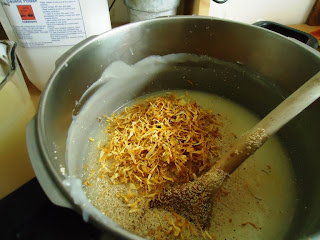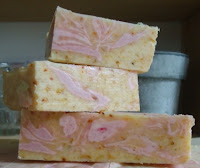If you can cook then there is no reason why you can not make your own soap. I like to make my own soaps because I am able to ensure that it is pure, safe and gentle enough to use on babies and toddlers. Most commercial soap makers use questionable synthetic fragrances, preservatives, chemicals and animal fat in their soaps. In addition making your own soap from scratch is very satisfying!! I have enjoyed making soap for our business but also just for me and hubby and the family to enjoy. It also makes your house smell wonderful. So why not give it a go, its easier than you imagine.
It's a good idea to get all your equipment, ingredients together and your choice of mould greased and lined before you begin.
It will make the whole process less fraught and you will feel more confident. I would also recommend that you read through the method first before you start instead of as you go along. I am going to make a basic soap, but if you get hooked on soap making you'll find that there are loads of books with recipes for all kinds of soap!! Olive oil castile soap is very moisturising, as are milk based soaps. This soap recipe is also moisturising and kinder to your skin than any soap you could buy in the supermarkets.
For a basic soap you will need the following:
615g coconut oil (solid) You could substitute some of the coconut oil for beeswax which helps makes a firmer bar of soap.
670g sunflower oil and the same of olive oil.
295g caustic soda (lye)
930ml still mineral water
You can also add essential oils, cosmetic colourants and other supplements for example: rose petals, calendula petals or poppy seeds.
Water and oil measurements have to be approximate and it is essential that the caustic soda is measured with exacting accuracy. Care should be taken using caustic soda as it will burn the skin on contact, happily after the curing process it is completely harmless.
Okay to get started, melt the solid fats first in a large pan, then add the liquid oils and remove from the heat. Put water into a large plastic bucket. Weigh the caustic soda and pour directly into the water, stirring constantly.
Using the thermometers ensure that oils and lye water are both at 35-36.7C/95-98 F.
When they are both at this temperature, add the lye water to the oils. This is the start of the saponification process. Stir continuously until the soap traces or in other words thickens and becomes opaque. You will know it is ready when the impression of a line of soap can be seen on the surface after drizzling from a spatula.
Depending on the oils used, temperature of the room, how vigorously you stir, tracing can take a matter of minutes or an hour or two. 30 -40 minutes is the average time.
Add colours, supplements if using, then essential oils, while stirring.
I made a marble soap, so added some colour to the mixture in a separate jug and stirred.
Pour into prepared mould which should be lined and greased.
I added the coloured soap to the mould and swirled to make a random pattern.
Cover with sheets of cardboard and thick towels. Set for 24 hours.
I used Lemon Peel Granules and Calendula petals as supplements and deep pink colourant. The essential oils I used were: Cinnamon Leaf, Tea Tree, Sweet Fennel, Lemon, Linaloe Wood, Peppermint and Basil to create my favourite soap Naughty Naked Bear.
After 24 hours we demould the soap on to greaseproof paper.
Wear gloves as the soap will still be caustic. Peel the greaseproof paper lining from the soap, then cut into bars. Leave to cure for 6-7 weeks in a warm dry place on waxed paper.
This is what they look like after being cut into bars:

You can wrap and label your bars of soap if you wish once they have cured.
There are lots of websites, suppliers and books available to help you quickly became skilled at soap making.


















No comments:
Post a Comment